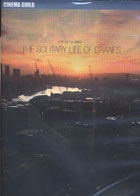
The Solitary Life of Cranes 2008
Distributed by Cinema Guild, 115 West 30th Street, Suite 800, New York, NY 10001; 212-685-6242
Produced by Odd Girl Out Productions presents in association with the
Channel 4 British Documentary Film Foundation
Directed by Eva Weber
DVD, color, 27 min.
Jr. High - Adult
Architecture, Urban Studies, Psychology, Sociology
Date Entered: 01/25/2010
Reviewed by Gary Handman, University of California BerkeleyEvery day on my walk into campus for the past year or so, I've made it a point to stop and check out the gargantuan cranes that hover and wheel over several construction sites. (My fascination is probably an atavistic, boy thing...). I'm consistently awed and slightly unnerved by the height and seeming fragility of those enormous, majestic machines. And what about the guys waaaay up there in those tiny, precarious cabins atop the tower, the unseen operators who ride and operate the monsters? What manner of men are those? What do they see from their stratospheric perches? What do they think about working up there in the clouds and weather every day? In The Solitary Life of Cranes, filmmaker Eva Weber provides visually stunning answers to many of these questions, along with unexpectedly deep philosophical insights into the lives and habits of the ordinary mortals on the ground below.
While the aerial scenery is transfixing and alone worth watching, Weber's film is not really about cranes at all. (We never really see what kinds of work these structures and their operators are performing). Instead, it's a lovely and rather profound meditation on the mysterious and poetic daily life, rhythm, and drama of cities—in this case, London specifically. It's also about the revelations possible by observing the extraordinary and often obscured details of everyday life from radically different vantage points.
In a sense, The Solitary Life of Cranes is closely related to the abstract and poetic, 1920s cinematic paeans to the metropolis known as "city symphonies." But whereas the city films of cinematic experimenters such as Walter Ruttmann (Berlin, Symphony of a Great City) and Dziga Vertov (Man With a Movie Camera) were largely silent and without inter-titles, Weber's film capitalizes on the interplay between the voice-over observations of crane operators and the astounding, panoramic images seen through their eyes. We catch only fleeting glimpses of the operators' faces (just like those observing cranes from the ground), which is rather frustrating, given the distinctive and insightful nature of their individual observations. The crane men comment on the joys of solitude; the loneliness of crowds and the foibles of individual urban dwellers and workers. They describe the euphoria of watching the changing heavens and earth, the patterns and textures of daily life, from hundreds of feet up. They revel in a kind of privileged access to things that usually go unseen, and they indulge in creative speculation about the anonymous lives that they witness daily. They also explain the let-down of having to descend back to earth at the end of the day—"cab happy" they call it.
While it's somewhat difficult to determine how and in which courses of academic study this film might be used (architecture? Urban planning? Sociology?), it's a beautiful and uniquely moving work which deserves watching simply for the joy and wonder of it.